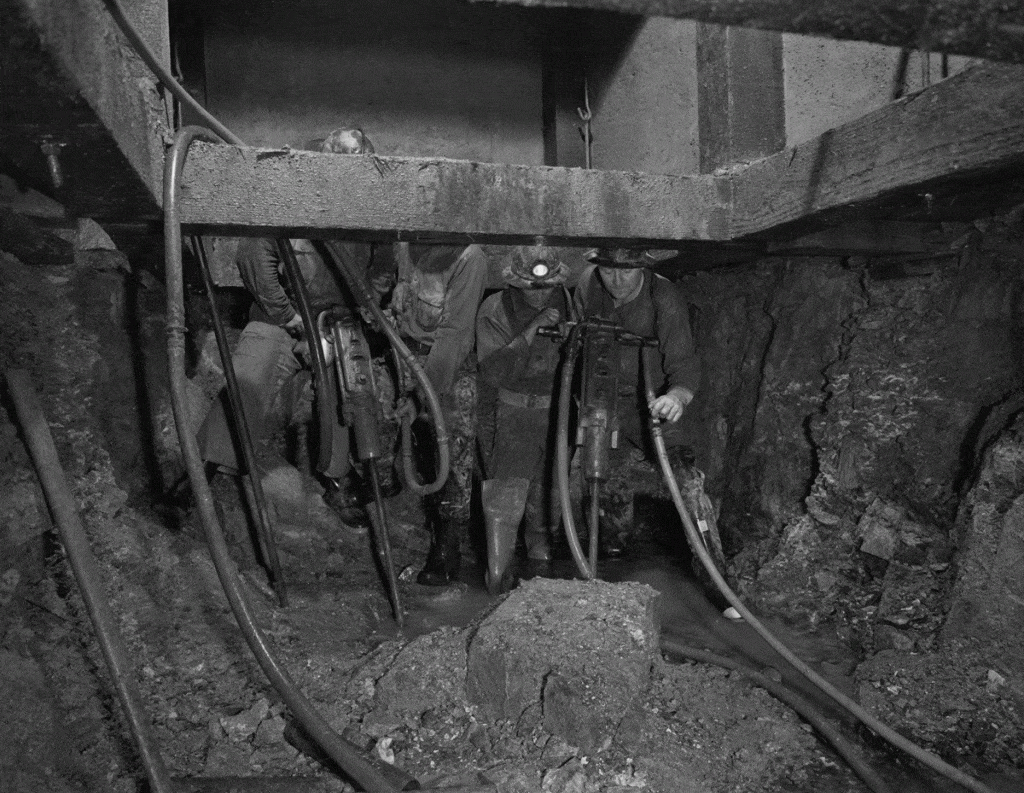This history is written from the perspective of a figurative miner at the Mayflower Mine, based on interviews and information from Keith Droste, Jim Hewitson, Gary Kimball and Steve Leatham, along with other historical research. The details of the miner are historicized, while the other information is historical. This is the second of two articles.
After I got hired to the Mayflower Mine, our primary production shaft ultimately reached a depth of 3,600 feet. The mine shared geothermal linkages with the Heber Valley ecosystem. The valley is studded with hot springs (referred to locally as hot pots) – the most famous “hot pot” being the caldera at the Homestead Resort. Below 3,000 feet the mine’s ambient temperature approached 150˚ F.
Hecla’s financial power funded the construction of a new mill (operational in 1962), expansion of the Union Pacific railroad spur, and the deployment of innovative labor-saving technology. Industry leading safety procedures were sacrosanct. In the ten years I worked at the Mayflower there were no fatalities. And yes, we extracted significant amounts of gold. In 1966 the mine was the sixth-largest gold producer in the country.
My innate mechanical skills were an advantage. I quickly established myself as one of the mine’s “go to guys” when it came to the dewatering and air-cooling subsystems. I enjoyed the responsibility, recognition, and premium pay. Combating the heat required the installation of a 240-ton capacity Carrier chilled-water air cooling system. Plumbing transported the chilled water through radiation coils and fans to the oppressively hot working locations, ensuring habitable working conditions below 3,000 feet. Once an area was exhausted, the “plumbing” required relocation to the next extraction zone.

Credit: Park City Historical Society & Museum, Beryl Ott and Tura Holm Springer Collection
Working at the Mayflower was an honor and privilege. I was fortunate to meet many outstanding folks. Two colleagues in particular stand out – Keith Droste and Jim Hewitson. Keith was our Superintendent from 1966 to 1969. He was one of the most humble, capable gentlemen that I ever met. In a way he was larger than life.
Keith held a B.S. in Geology (Class of 1955, Monmouth College, Monmouth Illinois) with advanced studies in chemistry, mathematics, and language. He was an accomplished runner and skier. In monthly meetings he reviewed our profits and losses while preaching the importance of a “holistic” perspective on our business. He was all about “net smelter value” which calculated all costs incurred to produce a finished product. Some of these costs were under our control, most were not.
Jim Hewitson joined us in 1967 as an intern from the University of Utah mine engineering program. Like Keith, Jim was both humble and impressive. He came from a fourth-generation Park City mining family. Besides enrolled in a grueling academic program, Jim worked full time as night watchman at United Park City Mines’ Keetley complex. Upon completing his mine surveying course (conducted at the 1,630-foot level) Jim returned to the “U’ to complete his studies. He graduated Cum Laude in the spring of 1970 with a B.S. in Mining Engineering.
Hecla managed their properties “by the numbers” with no regard for institutional emotions and/or sympathies. Their practicality could not be faulted. By the late 1960s the tide was turning against the Mayflower Mine, though Keith’s teachings served us well. Commodity prices declined and our production costs spiraled as our drilling depths increased and the quality of ore declined. Salt Lake’s once vast smelting and milling businesses gradually closed under the twin burdens of environmental regulations and aging facilities. Our transportation and processing expenses doubled. The Utah State Legislature compounded our misery with large tax assessments further eroding our return on investment. The mine remained profitable but barely so. I sensed the end was near.
In 1972 the Board of Directors decided to close the mine, even though it had been profitable for ten years. The macro trends, however, were omnipresent and irreversible. Shutdown required six months; All equipment that could be salvaged was. Owing to my expertise regarding our pumping and AC subsystems, and their necessity to enable a coherent shutdown, I remained employed to the bitter end. As the portal was sealed and the surface buildings padlocked, I reflected on those ten extraordinary years working at the Mayflower Mine – experiencing a corporate culture that encouraged collaboration, brought an esprit décor, and placed no limits on one’s potential.